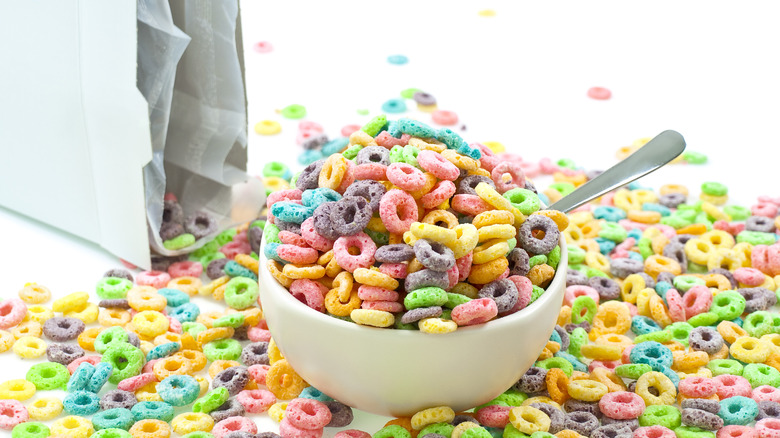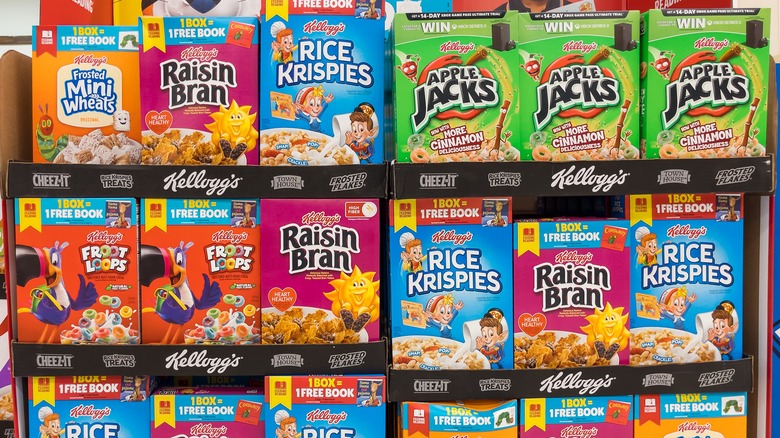When Were Toys First Added To Cereal Boxes And Why Did They Stop?
Picture it: You're eight years old. It's Saturday morning. You're sitting at the kitchen table, bowl in front of you, new cereal box in hand. You're struggling to get the box open but when you finally do, you don't pour the cereal into your bowl. Instead, you dive to the bottom of the box, searching anxiously for something that doesn't feel like flakes or crispies. Finally, you've got it: the toy, the essence of victory! This was the excitement of cereal box toys. Those plastic tchotchkes might have only held your attention for a few minutes before you forgot about them forever, but the build-up was worth begging your parents for the cereal they came in.
Believe it or not, the very first cereal promotion was aimed at adults and was launched at the beginning of the 20th century. It wasn't long before companies realized the real golden ticket was with children, but they didn't start putting prizes in the boxes right away. Indeed, prizes for purchasing cereal existed as early as 1909, but obtaining them wasn't as simple as opening the box. The pioneer of prizes in a box was actually Cracker Jack, who began putting toys in its boxes of caramel corn and peanuts in 1912. Still, it was decades before cereal companies followed their lead.
The golden years of cereal toys
In 1905 — way before people were drawn into consumerism by TV commercials – Quaker Oats ran a promotion where tokens were placed in their boxes of oats. If people collected enough tokens, they could trade them in for real china bowls. Four years later, Kellogg's offered an in-store prize to anyone who purchased two boxes of Corn Flakes. At checkout, the recipient received a copy of "The Funny Jungleland Moving Pictures Book." They soon shifted the prize from an in-store promo to a mail-in option. The nation was smitten by the idea and, just three years later, Kellogg's had given away 2.5 million books.
In the 1920s, Kellogg's cereal giveaways were still going strong, but by this time, many promotions required customers to mail in box tops to obtain prizes. The following decade, General Mills started offering prizes inside the box. Wheaties boxes came with one of twelve trading cards featuring Skippy, a popular comic book character. By the mid-1940s, Kellogg's got in on the hot trend and put small pin-back buttons inside boxes of PEP cereal, which first featured World War II U.S. military symbols, then characters like Superman, Popeye, and Little Orphan Annie.
As technology progressed and companies were able to produce small toys at lightning speed, more and more cereals were touting toys and prizes to eager children. All in all, the cereal box prize trend was strong for over half a century.
Where did the toys go?
Kids who grew up in the 1950s through the early 2000s were accustomed to the treasure troves hidden at the bottom of cereal boxes. They discovered things like plastic cartoon figurines, bike reflectors, and even glow-in-the-dark pens and terrariums(for real). But in the mid-2000s, in-box cereal prizes began to slowly die away. There isn't a clear-cut, singular reason for this; It was likely a combination of factors such as environmental reasons (less waste), the possibility that some toys could break and become choking hazards, and companies wanting to cut extra costs.
Cereal prizes have not completely disappeared, but they have taken different forms. Instead of toys, kids have had the opportunity to collect comic books or been given QR codes to access games and activities on their smartphones and tablets. In 2020, General Mills did put toy figures in some of their cereal boxes in a sort of throwback promotion. While it's hoped that a whole new generation of youngsters got the thrill of digging down deep into their freshly opened boxes of cereal, it's also just as likely that their parents scooped up the boxes to relive their childhood antics.
Even at the risk of sounding like our grandparents, those of us who grew up during those cereal toy years can't deny that those chintzy goods at the bottom of the box beat even the best QR code every time.


